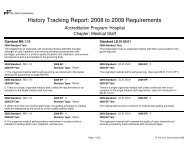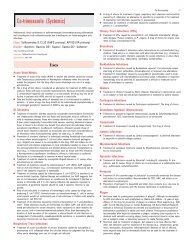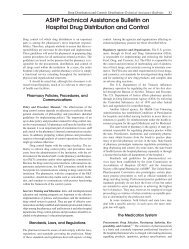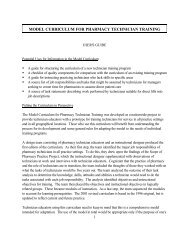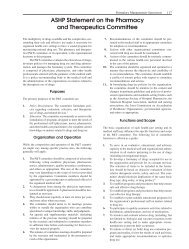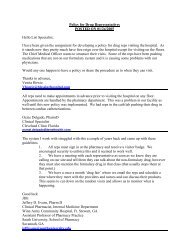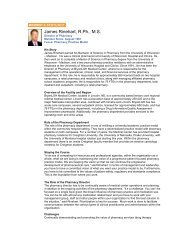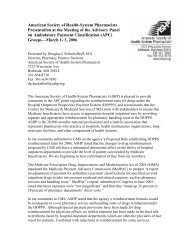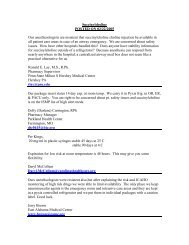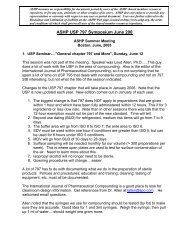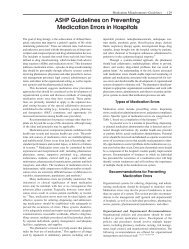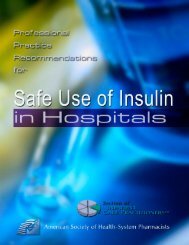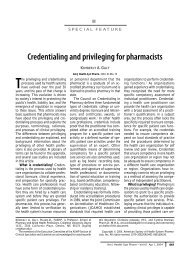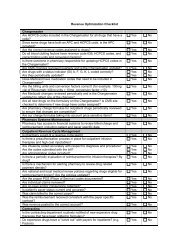NSAIDs Conversion tools - American Society of Health System ...
NSAIDs Conversion tools - American Society of Health System ...
NSAIDs Conversion tools - American Society of Health System ...
Create successful ePaper yourself
Turn your PDF publications into a flip-book with our unique Google optimized e-Paper software.
ASHP assumes no responsibility for documents posted by users <strong>of</strong> the ASHP shared members<br />
resources repository, or for any acts, omissions or other conduct <strong>of</strong> its users. ASHP does not<br />
endorse or provide any representation or warranty with respect to any user or posted document.<br />
Users are further referred to the Disclaimer and Limitation <strong>of</strong> Liability on the ASHP Web page,<br />
located at http://www.ashp.org, the terms and conditions <strong>of</strong> which shall govern all uses <strong>of</strong> the<br />
shared member resources repository.<br />
<strong>NSAIDs</strong> (Nonselective and COX-2 Selective Agents)<br />
<strong>Conversion</strong> Tools for UW Medicine and WA<br />
Generic <strong>NSAIDs</strong> Available<br />
NSAID Class Generic Name NSAID Class Generic Name<br />
Salicylates Salsalate Acetic acids Dicl<strong>of</strong>enac potassium<br />
Propionic acids Fenopr<strong>of</strong>en<br />
Dicl<strong>of</strong>enac sodium<br />
Flubripr<strong>of</strong>en<br />
Etodolac<br />
Ibupr<strong>of</strong>en<br />
Sulindac<br />
Ketopr<strong>of</strong>en Oxicams Piroxicam<br />
Naproxen<br />
Naphthylalkanones<br />
Nabumetone<br />
Naproxen sodium<br />
Oxaprozin<br />
Brand-only <strong>NSAIDs</strong>:<br />
NSAID Class<br />
Semi-selective COX-2 inhibitor<br />
Selective COX-2 inhibitor<br />
Generic Name / Proprietary Name<br />
Meloxicam / Mobic®<br />
Celecoxib / Celebrex®<br />
Evaluating Patients & Appropriate Use, and <strong>Conversion</strong> Processes<br />
1. Stratification <strong>of</strong> Patient Risk<br />
• Cost outcomes studies to date have indicated that the most cost-effective use <strong>of</strong> COX-2 agents is in patients<br />
considered to be at high risk for GI complications.<br />
• Stratification <strong>of</strong> patients by GI risk is generally recommended in selecting an agent, however it is notable that<br />
there are little data to substantiate a lower incidence <strong>of</strong> GI bleeding or ulceration in high-risk patients. This<br />
approach is an extrapolation <strong>of</strong> the data. In one trial (Francis KL, NEJM 347;26:1104) comparing celecoxib to<br />
a dicl<strong>of</strong>enac-omeprazole combination therapy in patients with a recent history <strong>of</strong> GI bleed, there was no<br />
significant difference in the incidence <strong>of</strong> serious GI outcomes between the treatment groups. However, the<br />
relatively high incidence <strong>of</strong> GI events indicated that none <strong>of</strong> the treatments protected patients from recurrence<br />
<strong>of</strong> adverse outcomes. Thereby providing a message <strong>of</strong> caution to treating high-risk patients with any NSAID<br />
regimen.<br />
2. Considerations for Use <strong>of</strong> a COX-2 Selective Agent<br />
• COX-2 agents are not recommended for routine use in patients with acute pain or general musculo-skeletal<br />
complaints. COX-2 agents are indicated for patients with confirmed diagnosis <strong>of</strong> rheumatoid arthritis or<br />
osteoarthritis that<br />
• (per UW and MAA policy) are considered at high-risk for a serious GI event.<br />
• (per MAA policy) have experienced therapeutic failure with several nonselective <strong>NSAIDs</strong>.<br />
• Use <strong>of</strong> non-steroidal anti-inflammatory agents in patients at high risk for serious GI complications should be<br />
considered cautiously as both selective and non-selective agents may still increase risks. Patients<br />
considered at the high risk are those with a previous clinical history <strong>of</strong> a gastroduodenal ulcer or perforation<br />
or GI bleed. Other risk factors include: advanced age (> 65 years), concomitant anticoagulant or glucocorticoid<br />
therapy, severe systemic disease).<br />
• Utilization <strong>of</strong> a proton-pump inhibitor (PPI) in combination with a traditional NSAID agent can improve<br />
tolerability and decrease risk <strong>of</strong> serious GI events. The cost-effectiveness <strong>of</strong> this combination therapy versus a<br />
COX-2 selective agent should be assessed, especially in light <strong>of</strong> the availability <strong>of</strong> lower cost, OTC and<br />
generic PPI agents.<br />
• All <strong>NSAIDs</strong> can worsen hypertension and may exacerbate heart failure and have other renovascular effects<br />
that may be undesirable in patients with cardiovascular disease. R<strong>of</strong>ecoxib was voluntarily withdrawn from the<br />
market secondary to increased incidence <strong>of</strong> myocardial infarction in trials comparing the agent to non-selective<br />
NSAIDS. While data is inconclusive regarding CV risks selective and nonselective agents, the FDA has
equired a black box warning for all <strong>NSAIDs</strong> in patients with cardiovascular disease and contraindicates the drugs in<br />
patients who have recently undergone cardiac bypass surgery.<br />
3. Converting Patients to Preferred <strong>NSAIDs</strong><br />
Key Steps in the Assessment and <strong>Conversion</strong> Process<br />
#1. Determining appropriateness <strong>of</strong> NSAID therapy and use <strong>of</strong> non-preferred agents.<br />
• MAA-DSHS has developed a program to decrease morbidity and mortality from NSAID-associated<br />
adverse GI event (i.e., bleeding, ulcerations). All patients presenting with a prescription for an NSAID<br />
(COX-2 selective or traditional/nonselective) must be evaluated for GI risk. Furthermore, use <strong>of</strong> nonpreferred<br />
<strong>NSAIDs</strong> must meet particular criteria.<br />
• Use the “NSAID/COX-2 Decision Tree” (located at end <strong>of</strong> document) to assist you in working through<br />
these criteria. It is advised that the <strong>of</strong>ficial MAA-DSHS policies be reviewed.<br />
#2. Converting patients to preferred agents via the Therapeutic Interchange Program (TIP) or<br />
making recommendations for preferred agents and doses.<br />
• Determine which NSAID products the patient has used in the past and avoid converting to those<br />
associated with therapeutic failures or intolerances.<br />
• For patients requiring routine NSAID therapy (i.e., OA, RA), use the <strong>Conversion</strong> Dosing Guide for<br />
Chronic NSAID Therapy (Table 2) to assist you with selecting a preferred agent and dose. You may also<br />
refer to the Comparative Table <strong>of</strong> Adverse Effects <strong>of</strong> Nonselective <strong>NSAIDs</strong> (Table 3).<br />
• For patients requiring intermittent (PRN) NSAID therapy for mild to moderate pain, select an agent with a<br />
shorter duration <strong>of</strong> action or a non-sustained release formulation and use the low to moderate dose<br />
recommendations in Table 2. Ibupr<strong>of</strong>en and naprosyn are the most widely used agents for these types <strong>of</strong><br />
indications.<br />
• Intrapatient variability in response to <strong>NSAIDs</strong> is common and can lead to therapeutic failures. Patients<br />
<strong>of</strong>ten need consecutive trials with several agents. Traditional recommendations have been to switch to<br />
agents in different chemical classes and, while there is no harm in this approach, there is no data to<br />
support its effectiveness.<br />
#3. Patient education and consultation<br />
• The patient should be counseled on the rationale behind this conversion.<br />
• The patient should be specifically instructed to stop the previous NSAID agent and begin taking the new<br />
agent with emphasis on the risk <strong>of</strong> using both medications (including OTC preparations).<br />
• Counseling should include advising the patient on adverse reactions that may occur with all NSAID<br />
medications and what to do should they experience any significant reactions (ie, blood in stool)<br />
• The patient should be advised to contact the pharmacy for any questions related to the medication or to<br />
contact their physician/prescriber for any health-related concerns.<br />
#4. Notification <strong>of</strong> Prescriber Regarding <strong>Conversion</strong><br />
• All WA Rx therapeutic interchanges necessitate notification <strong>of</strong> the prescriber. It is recommended that this<br />
notification be completed within 24 hours by the pharmacist making the conversion and, for UW Medicine<br />
prescribers, that the documentation is completed in Powerchart.
Table 2: <strong>Conversion</strong> Dosing Guide for Chronic NSAID Therapy*<br />
NSAID Agent Low Dose Medium Dose High or Max Dose<br />
Salsalate 500-750mg bid 750mg tid 1000mg tid<br />
Fenopr<strong>of</strong>en 200-300mg qid 600mg tid-qid 800mg qid<br />
Flubripr<strong>of</strong>en 50mg bid 50mg tid-qid 100mg tid<br />
Ibupr<strong>of</strong>en 400mg tid 600mg tid-qid 800mg qid**<br />
Ketopr<strong>of</strong>en 25-50mg tid 75mg tid IR =300mg/day (divide), SR<br />
=200mg/day<br />
Naproxen 250mg tid 500mg bid 1250mg/day (divided)<br />
Naproxen sodium 275mg tid 550mg bid 1375mg/day (divided)<br />
Oxaprozin 600mg qd 1200mg qd 1200mg qd<br />
Dicl<strong>of</strong>enac potassium 50mg bid 50mg tid 50mg qid (in OA/RA only)<br />
Dicl<strong>of</strong>enac sodium 50mg bid 75mg bid 50mg qid or 100mg SR bid (in RA only)<br />
Etodolac 200mg tid 400mg bid 1200mg max (IR or SR divided doses)<br />
Sulindac 150mg bid 200mg bid 200g bid<br />
Piroxicam 10mg qd 20mg qd 40mg per day (not indicated for OA or<br />
RA)<br />
Nabumetone 1000mg qd 1000mg bid 2000mg/day (qd or divided bid)<br />
Meloxicam/Mobic®# 7.5mg qd 7.5mg qd 15mg qd<br />
Celecoxib/Celebrex®# 200mg qd 200mg bid 200mg bid<br />
R<strong>of</strong>ecoxib/Vioxx®# 12.5mg qd 25mg qd 50mg qd for max <strong>of</strong> 5 days (acute pain)<br />
Valdecoxib/Bextra®# 10mg qd 10mg qd 20mg bid (primary dysmenorrhea only)<br />
*This table does not represent exact or equivalent dosing conversions. It is based on FDA approved dosing ranges and comparative doses from<br />
clinical trials. Practitioners should exercise common sense in the practical application <strong>of</strong> this guide, including consideration for the patient’s NSAID<br />
history and current clinical status (i.e., renal function).<br />
Preferred Agents per WA Rx PDL UW PDF Agents<br />
#<br />
NON-preferred agents on Washington State Preferred Drug List. Require prior authorization<br />
Table 3: Comparative Table <strong>of</strong> Adverse Effects <strong>of</strong> Nonselective <strong>NSAIDs</strong> (Miyoshi, Boyce)<br />
Class<br />
Analgesic Gastrointestinal Platelets Renal Hepatic<br />
system<br />
toxicity toxicity<br />
Dyspepsia Bleeding<br />
Salicylates Salsalate + + 0 + +<br />
Propionic acids Fenopr<strong>of</strong>en + + + ++ +<br />
Flubripr<strong>of</strong>en + ++<br />
Ibupr<strong>of</strong>en ++ + + ++ +<br />
Ketopr<strong>of</strong>en + + + ++ ++<br />
Naproxen +++ ++ + ++ +<br />
Oxaprozin ++ + + ++ ++<br />
Acetic acids Dicl<strong>of</strong>enac ++ ++ + ++ ++<br />
Etodolac ++ + 0/+ + +<br />
Sulindac ++ + + + +<br />
Oxicams Piroxicam ++ + + ++ +<br />
Meloxicam + + 0 + +<br />
Alkanones Nabumetone + + 0 + +<br />
0=no effect, + minimal effect, ++ moderate effect, +++ strong effect, ++++ maximum effect
•<br />
Patient presents<br />
with NSAID or COX-2 Rx<br />
NO<br />
NSAID Rx<br />
Fill Rx<br />
History <strong>of</strong> GI bleed<br />
or ulcer?<br />
NO<br />
COX-2 Rx<br />
Criteria for Use (all required)<br />
1. Over 18 years <strong>of</strong> age<br />
2. Tried and failed OR<br />
intolerant to at least 2<br />
generic <strong>NSAIDs</strong><br />
3. Dx <strong>of</strong> one <strong>of</strong> the following:<br />
-Rheumatoid arthritis<br />
-Osteoarthritis<br />
-Acute Pain<br />
4. Agent-specific criteria<br />
YES<br />
1. Consider verifying<br />
GI history with<br />
prescriber and desire<br />
to use <strong>NSAIDs</strong>.<br />
2. Complete &<br />
submit: Rx Drug<br />
Authorization Request<br />
and NSAID/ COX-2<br />
Request forms<br />
Approved → Fill Rx<br />
Not approved →<br />
Address issue with<br />
prescriber<br />
Fill Rx with<br />
Appropriate<br />
EPA Code<br />
YES<br />
Criteria Met?<br />
NO,<br />
Option #1<br />
Call MD for change or use<br />
TIP policy to convert to<br />
preferred NSAID<br />
-Use conversion chart<br />
-Consider NSAID history<br />
NO,<br />
Option #2<br />
If COX-2 therapy<br />
desired<br />
-prescriber may<br />
submit PA & NSAID<br />
requests (2 forms)<br />
Fill Rx



